By Robert Waite
Oaxaca, Mexico – I have a confession to make. I tend to shy away from places whose names aren’t obvious to pronounce, much like someone might hesitate to order acai berries at a smoothie stand.
Oaxaca is one of those places. Hence, I have been to a dozen or more spots in Mexico but never ventured there. Until now.
I was lured by the city’s annual one-of-a-kind Noche de los Robanos (Radishes) festival, along with Oaxaca’s reputation as a stellar foodie destination and cultural center. Its reliably mild December weather was a bonus.
The language enablers were my Santa Monica-based daughter and her husband. Not only do they know how to pronounce Oaxaca – waa-haa-kuh – but some members of his family hail from there.
Oaxaca, with a population of about 700,000, is located in Mexico’s far south. At an elevation of 5,102 feet, its climate is pleasingly moderated, much as it is in places like Santa Fe and Taos, New Mexico.
Not your ordinary radishes
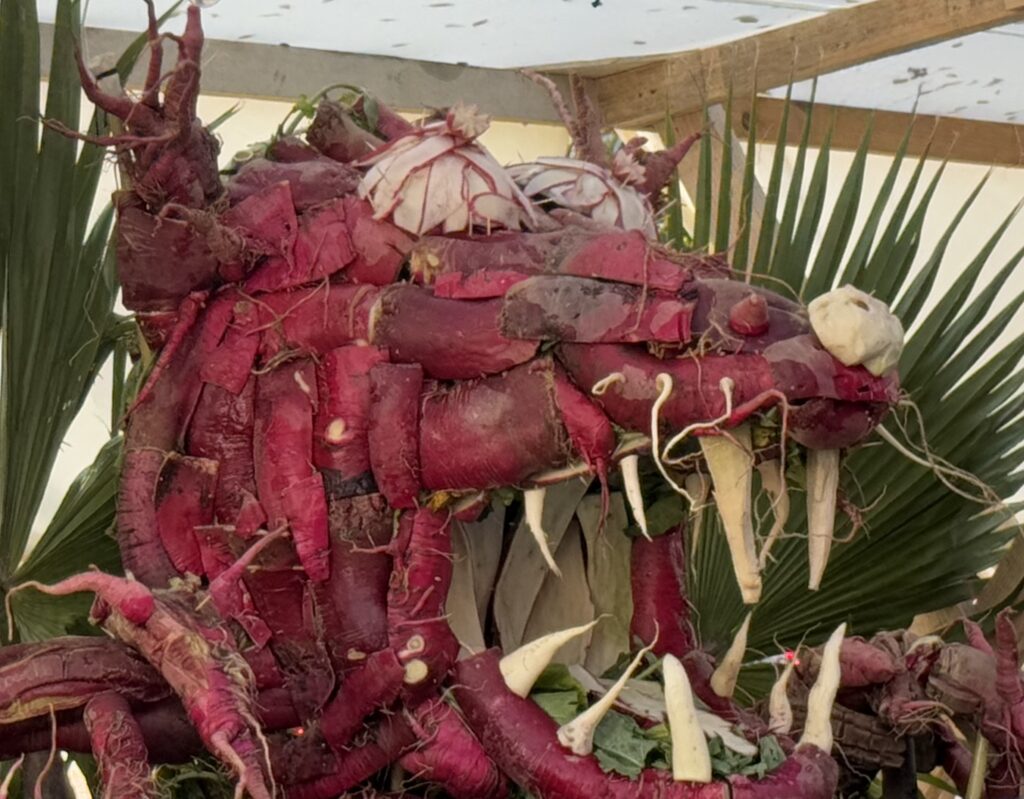
This toothy creature is all radish. Photo by Karen Shigeishi-Waite
As mentioned, a big draw was the Noche de los Robanos, formally established in 1897, dedicated to the carving of radishes.
We’re not talking about those dainty and demure radish slices you might see in a salad, but huge red taproots grown specially to go under the carver’s knife.
Each year on December 23, approximately 100 of these carvers frantically work at individual stalls set up in the city’s Zocalo, or main square. They skillfully turn their carefully selected radishes (a premium is put not only on size but purported “ugliness”) into everything from nativity scenes to local Indigenous folk tale characters, to space ships.
Carvers must finish by 5 p.m., when judging begins. While some of the contestants have been at it for 50 years or more, this year’s winner in the “traditional” category, Carlos Vasquez Lopez, was a 19-year-old student home from his university studies in Chicago. His entry, fittingly enough, was an homage to Oaxaca’s gastronomic creations.
The top prize was only $5,500 – so it is clear that the carvers work for love, not riches. All of which is to say that Castroville, California, may have its Artichoke Festival, and Morton, Illinois, one dedicated to the pumpkin, but for my money Oaxaca’s radish fest tops them all.
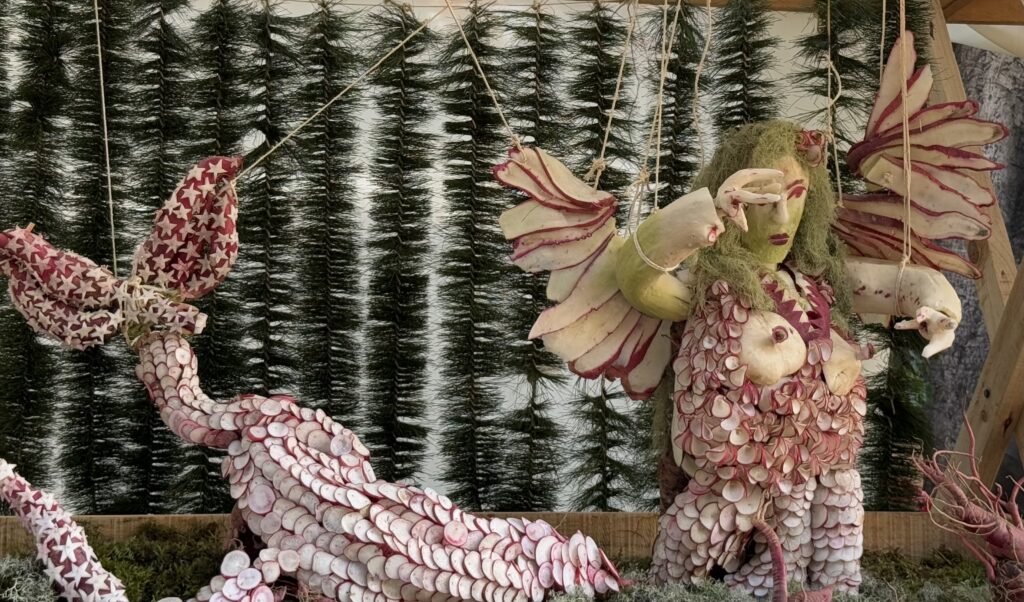
Some carvings are on the risque side, but have their origins in Zapotec stories and traditions. Photo by Karen Shigeishi-Waite
Beyond the Radish Festival
While we came for the Radish Festival, there is much more to do in this old colonial city and environs.
In the city itself stands the magnificent Museo de las Culturas de Oaxaca, with its 14 halls located in a 16th-century former monastery. The building itself is an architectural marvel and is worth a visit for that reason alone, but you’ll also be captivated by its collection of artifacts, including pre-conquest Zapotec items.
If you like impressively decorated churches, head to the Church of Santo Domingo. Construction on this Baroque structure began in 1575. On the interior the lavish use of gold leaf is a testament to the riches Spain extracted from its American colonies – and the inclination to turn a portion of those riches over to the Church.
We attended Christmas Day mass here and while we only half understood the sermon, we were impressed by the padre’s enthusiasm.
Also while in town you should certainly tour the city’s markets, take part in a cooking class — as we did — or perhaps do a guided foodie tour. Oaxacan chefs serve up more than 200 varieties of mole, a sauce often associated with chocolate (but which in the hands of local chefs comes in almost infinite manifestations).
Perhaps I shouldn’t mention the crispy grasshoppers that are incorporated into many of the dishes here, but if you see Chapulines on the menu, you have been forewarned.
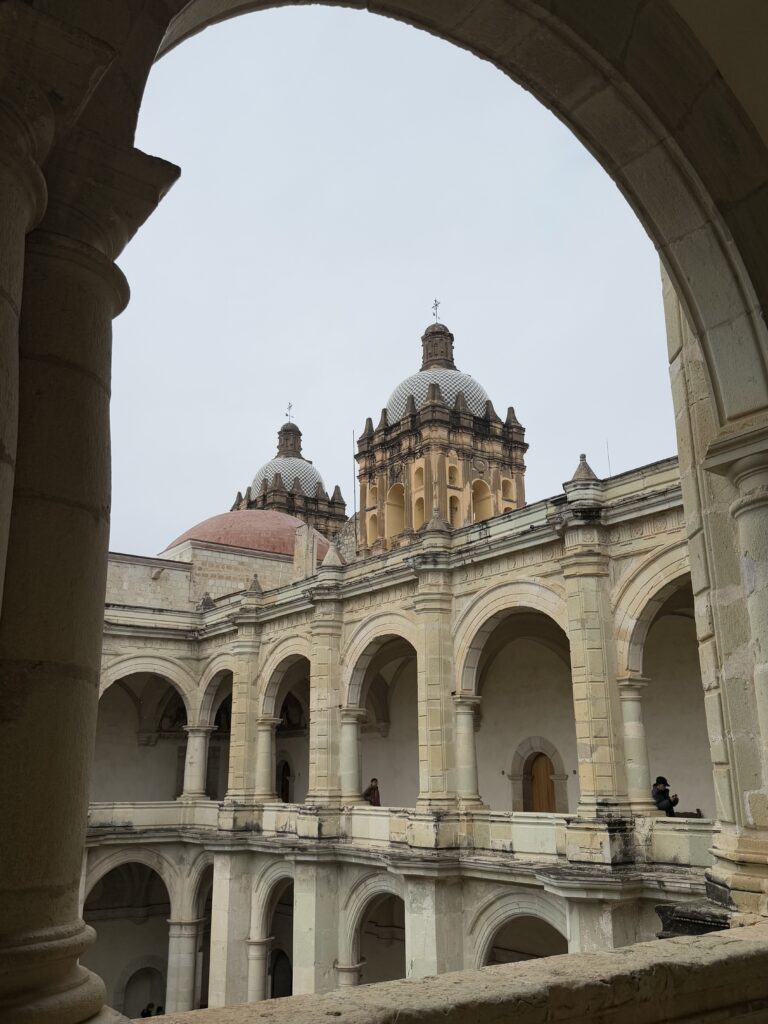
A former monastery, Oaxaca’s Museo de las Culturas is housed in a beautiful example of early-colonial architecture. Photo by Karen Shigeishi-Waite.
Near Oaxaca
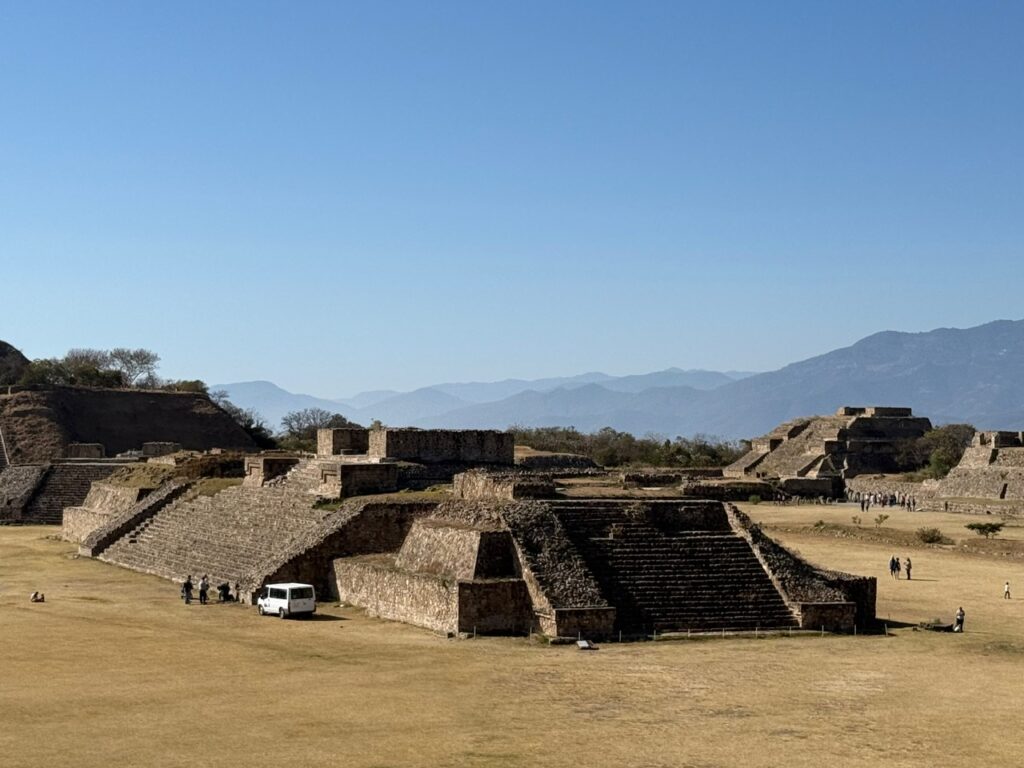
Monte Alban was constructed by the Zapotec civilization more than 2,400 years ago. Photo by Karen Shigeishi-Waite.
It’s also well worth venturing outside the city itself. Many tourists come specifically to see the Zapotec ruins of Monte Alban, about five miles away. It was once a gigantic and pulsating place, covering over 40 sq. km. (almost 10,000 acres). However, after approximately 20 centuries, and for reasons lost in the mists of time, it was abandoned.
Today it is certainly no longer abandoned, as both archaeologists and tourists are found in abundance. Among other things, you will find several pyramid-like structures, a ball-court, and the outline of living quarters.
Somewhat farther outside the city lies the Hierve el Agua (literally “the water boils” in English).
This set of natural travertine rock formations resemble cascades of water. If you hike down to the foot of the largest of these “waterfalls” you’ll be rewarded with a good photo background for your party.
Finally, when venturing out into the countryside, do not miss an opportunity to visit one of the many mezcal distilleries in the area. The proprietors will happily tell you about the cultivation of the agave plant, the difference between mezcal and its cousin spirit tequila, and host a tasting.
It’s better to do your sampling after visiting Monte Alban or Hierve el Agua.
It’s easy to see why so many flock to Oaxaca — I just wish I had learned to pronounce the name earlier. So, given my success pronouncing Oaxaca, I’m already lining up my next trip: the town of Llanfairpwllgwyngyllgogerychwyrndrobwllllantysiliogogogoch in Wales, of course.
IF YOU GO
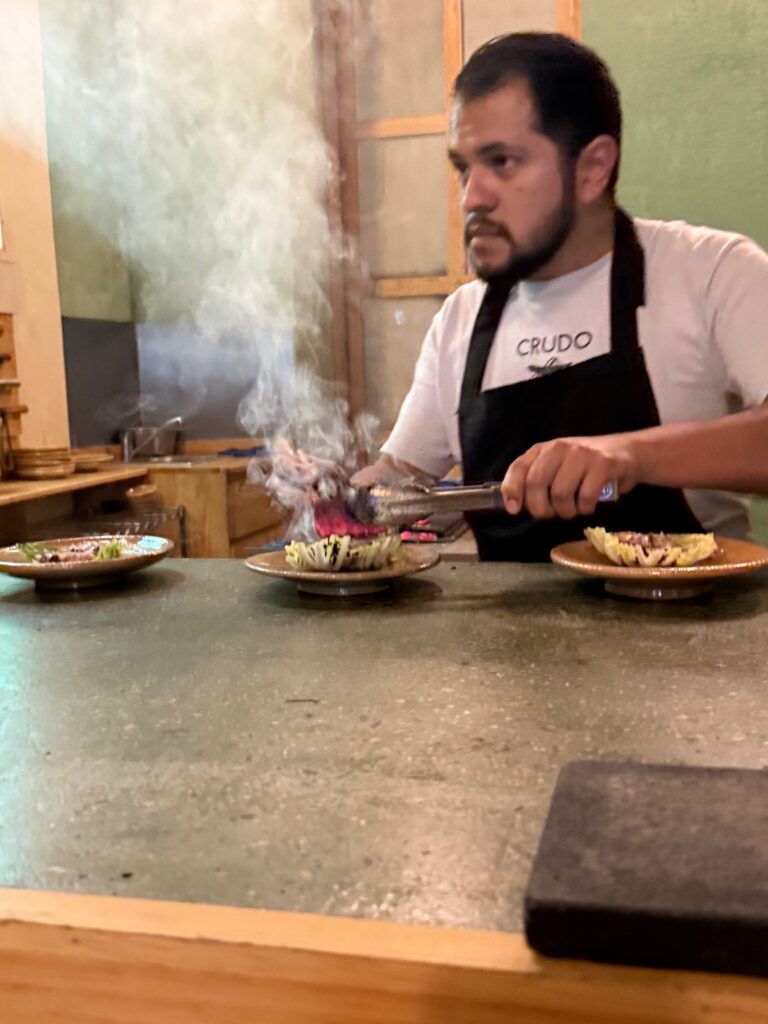
Crudo’s master chef Ricardo Arellano brings Mesoamerican flair to his Japanese omakase cuisine. Photo by Karen Shigeishi-Waite.
Getting There: There are direct flights from the U.S. to Oaxaca from Dallas, Houston, and Los Angeles. You can also connect from many North American cities via Mexico City. Two members of our group went to Tijuana to pick up a cheaper Volaria Airlines flight – they would definitely recommend not doing so after experiencing delays and cancelations.
Where To Stay : As there were six of us, we stayed at the spacious Casa Sabino, a short walk to the city’s main attractions. It can be found on Airbnb. There are many other entire-home choices. For hotels, NaNa Vida and Casa de Sierra Azul offer luxury accommodations just steps from the main square and cathedral.
When To Go: The nicest time to visit is December and January. The Fiesta de la Virgen de la Soledad gets underway on December 16; the Noche de Rabanos is on the 23rd. On Christmas Eve there is a colorful procession. The weather is typically excellent – warm but not hot sunny days, cool but not cold evenings.
Where To Eat: This is a foodie town with too many great restaurants to list here. But one we particularly enjoyed was Crudo. This Michelin Guide establishment is located in a small space with just 12 counter seats and must be booked in advance. The fare is Japanese omakase, but with a Mesoamerican flair created by Chef Ricardo Arellano.
The Radish Festival – During the day you can see the carvers at work by circulating around the stalls. Keep in mind that the later it gets, the more crowded the Zocalo becomes. By 5 p.m. there are so many people swirling about that it can be difficult to get a clear view, but if you are persistent, you will be rewarded.
Safety: Oaxaca has not been afflicted with the cartel-related violence that has sadly made many Mexican destinations dangerous. Its streets are generally safe, even in the evenings. Having said that, exercise prudence regarding the wearing of expensive jewelry; there are also occasional reports of pickpockets.
About the Author
Robert Waite has been writing on travel for more than 50 years. A four-time winner
of the New England Newspaper and Press Association’s Best Column Award, Robert is
also the author of Ipswich on My Mind and Ipswich Out of My Mind, a compilation of
humorous reminiscences about growing up in Massachusetts. The books are
available from Amazon as paperbacks or as a Kindle E-book. He and his wife reside in
Ottawa, Canada.
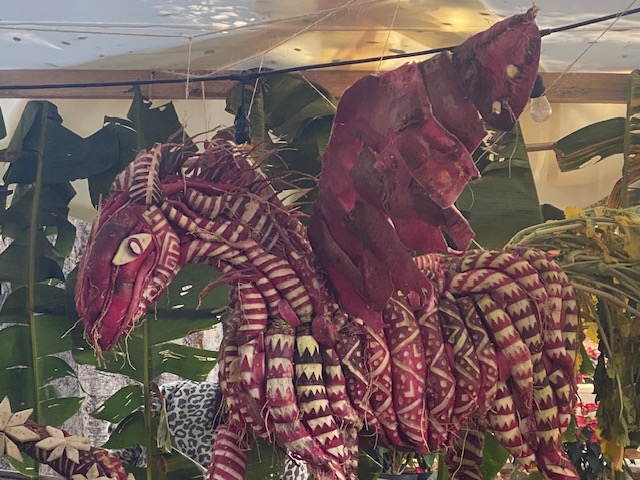
A carved dragon radish makes for a fiery display. Photo by Karen Shigeishi-Waite.
COMMENTS:
Great write up! Many thanks!
Makes me want to go! — Barry Goode barrygoode@hotmail.com
***********************************************************************
Thank you for the wonderful description of Oaxaca! I was certainly not pronouncing it correctly. I simply love radishes and so was intrigued about a radish festival. I do hope there was a tasting along with the creative sculptures. You always provide such a great read. Thank you Bob — Sandra Hudon sandra.hudon@polykar.com
************************************************************************
Another great posting from clarknorton.com. Robert is a great traveler and a great writer. While my own radish consumption will be limited to the “demure and dainty slices” Robert mentions, he has given us more ample food for thought with this article.— SteveA
************************************************************************
Thank you Bob, a great read and it brought back some good memories. We always enjoy your stories, we’ll done! –Stewart Roth
************************************************************************
Thank you for this. JD and I were planning to visit there because we heard they have good weavers. We have a Zapotec rug we bought during the Balloon Festival in Albuquerque. The carved radishes are amazing. Thank you Karen for taking those great pictures. Keep on trucking! — Nora Curran
************************************************************************
God Bless you for your adventures. Thanks for sharing. A place I will never see. — J Reeve Bright












8 Responses to Relish a Radish? Come to Oaxaca